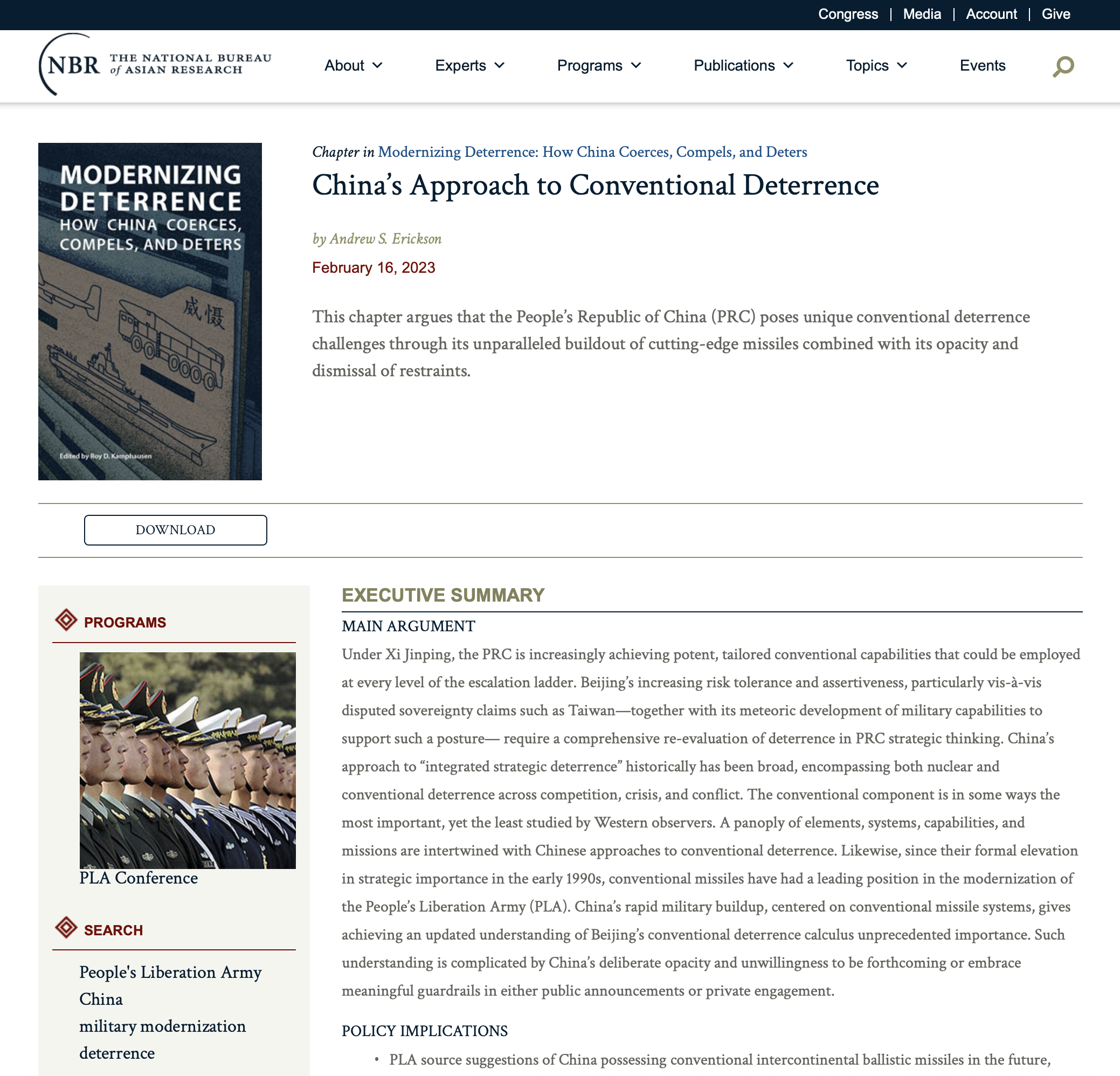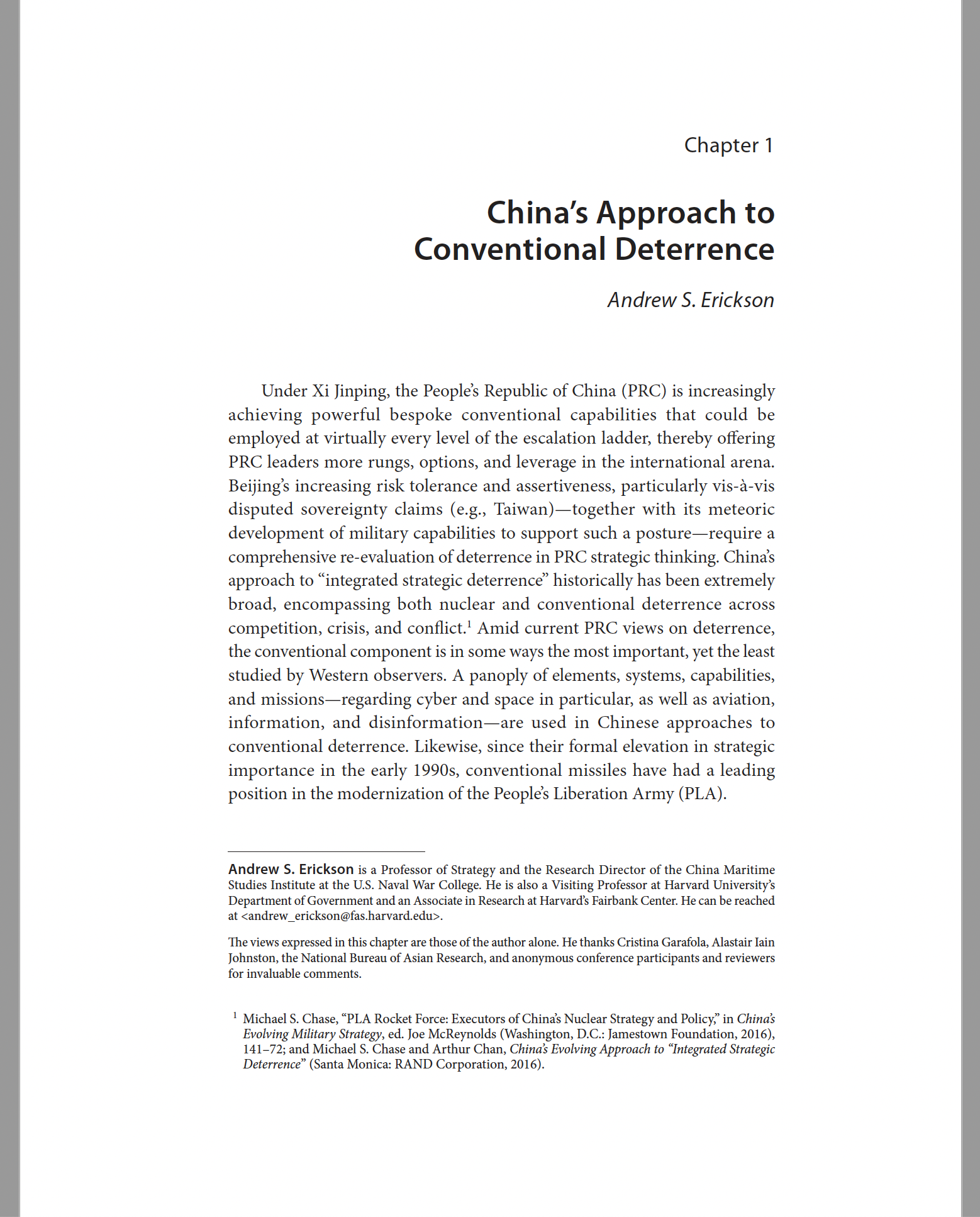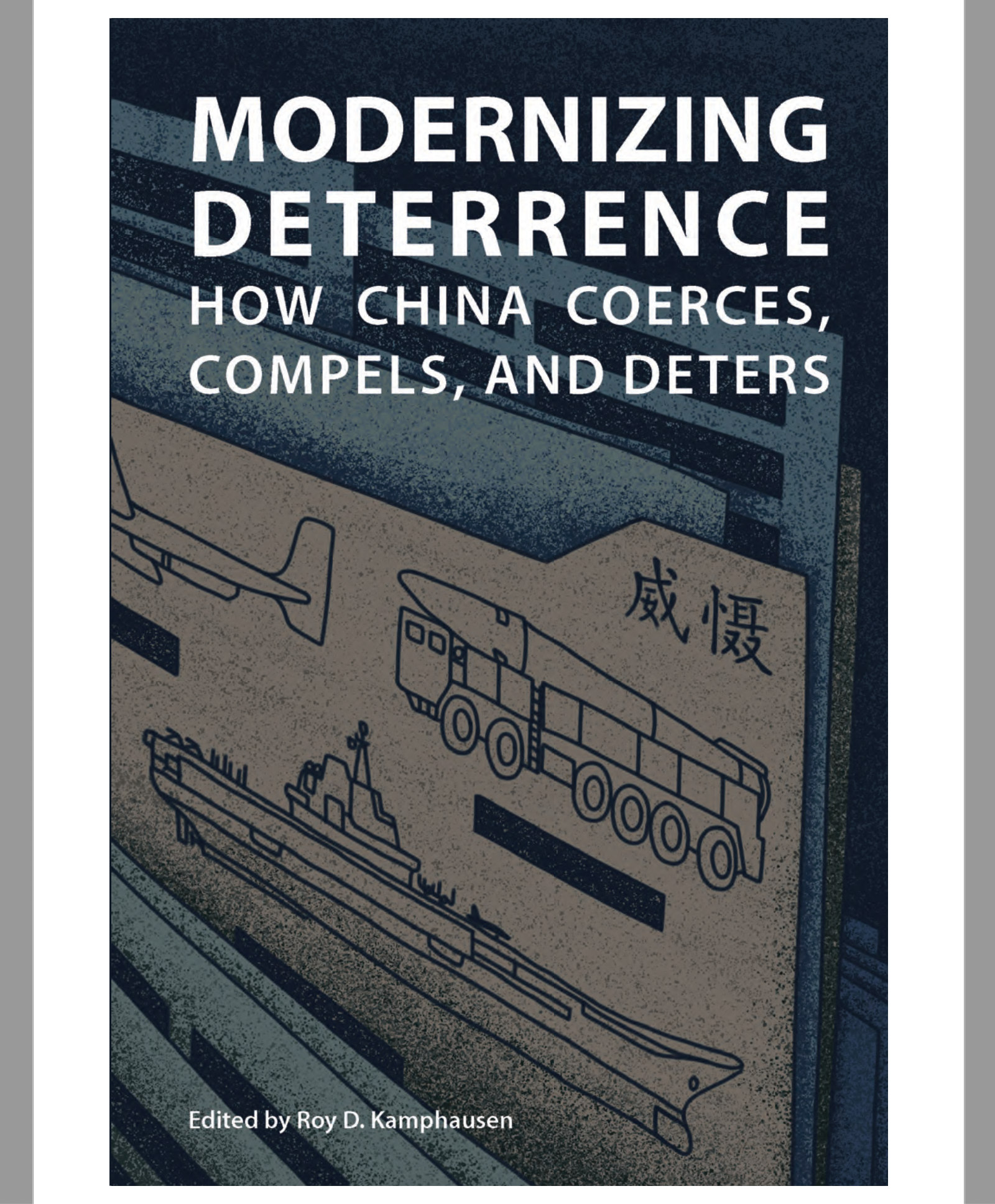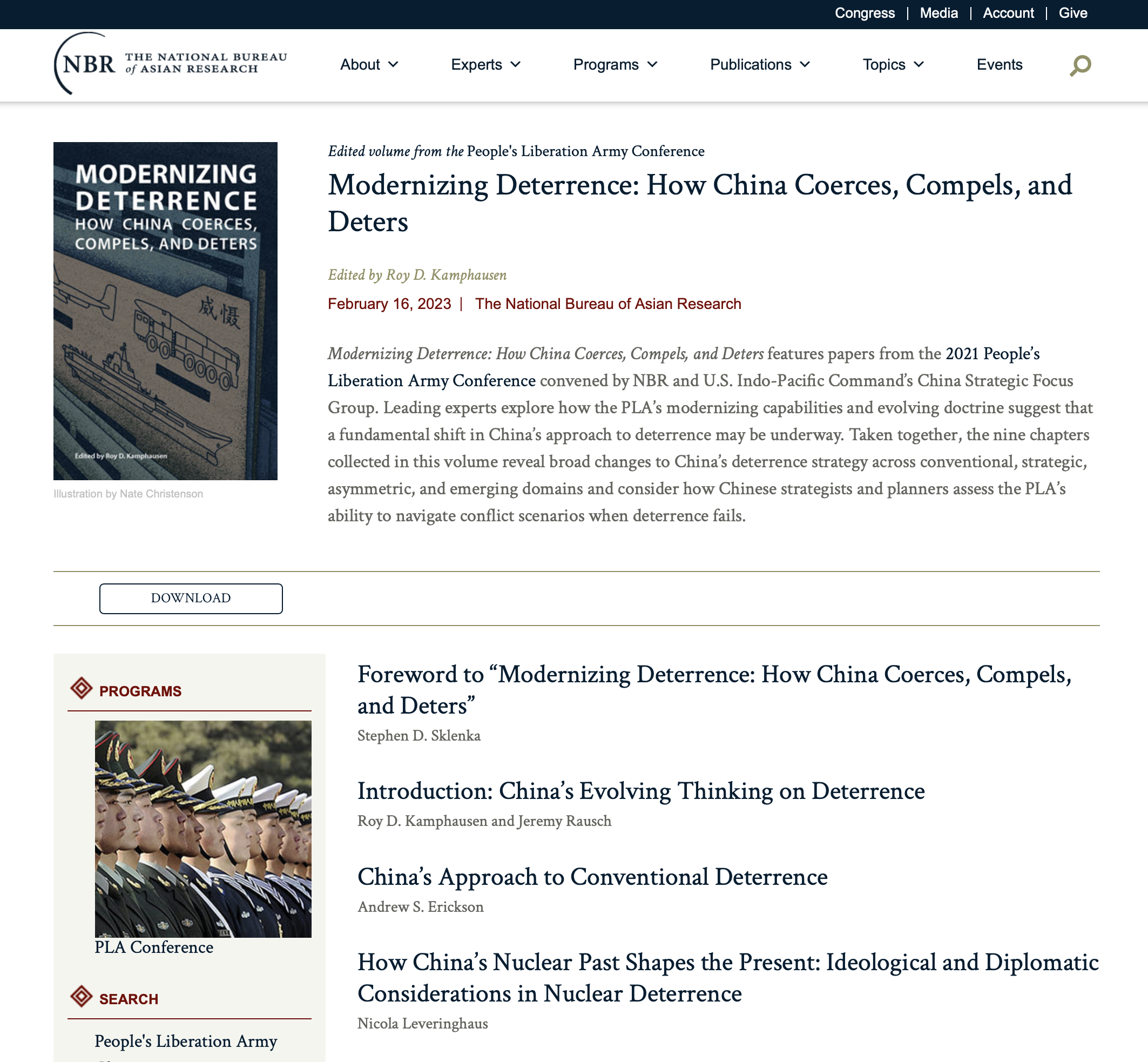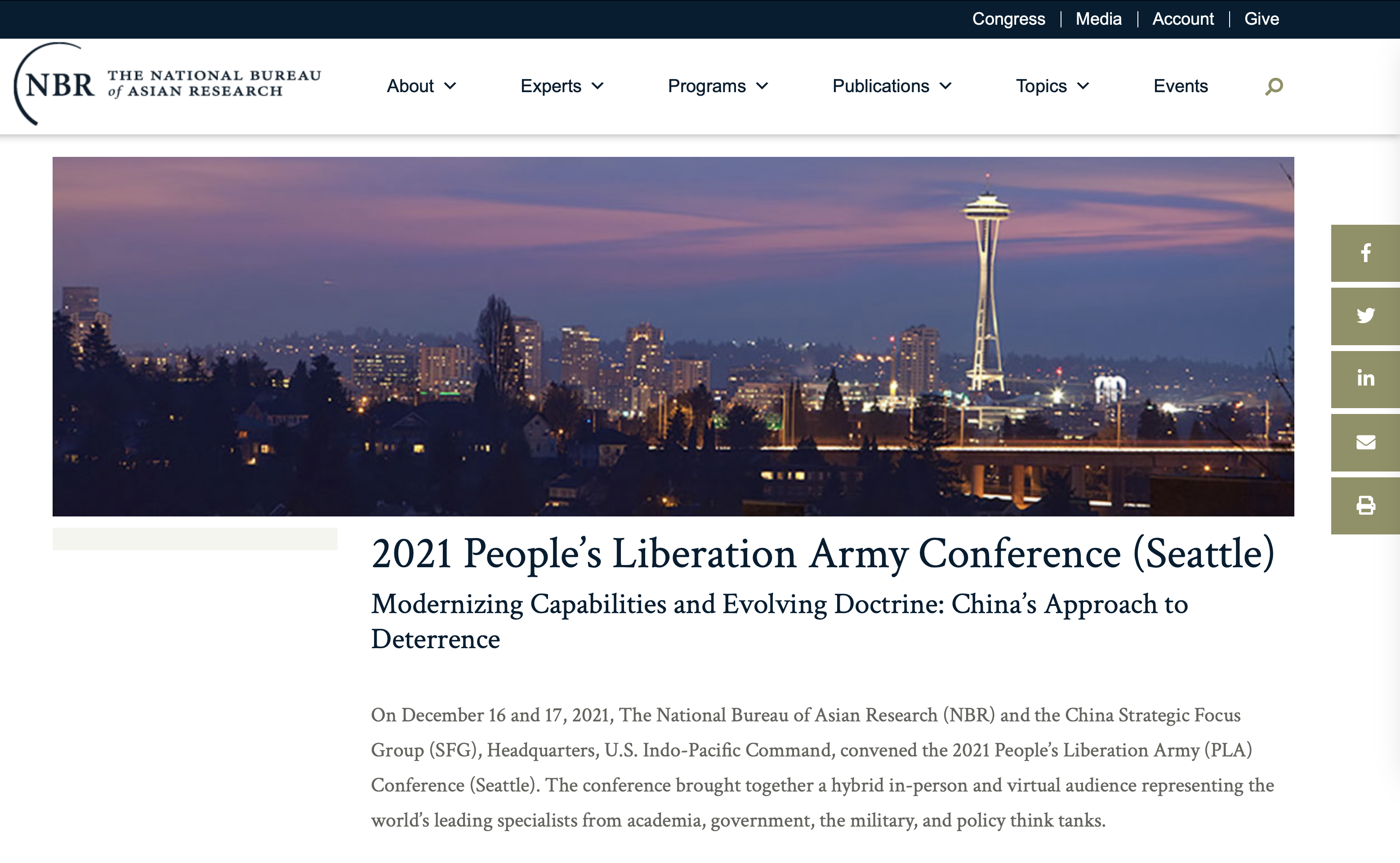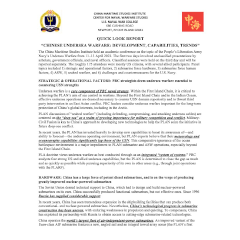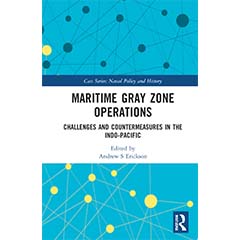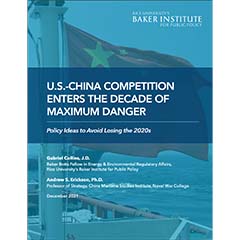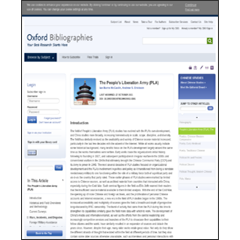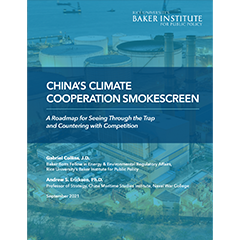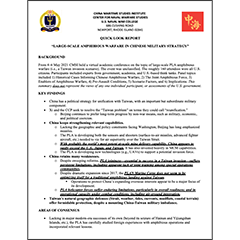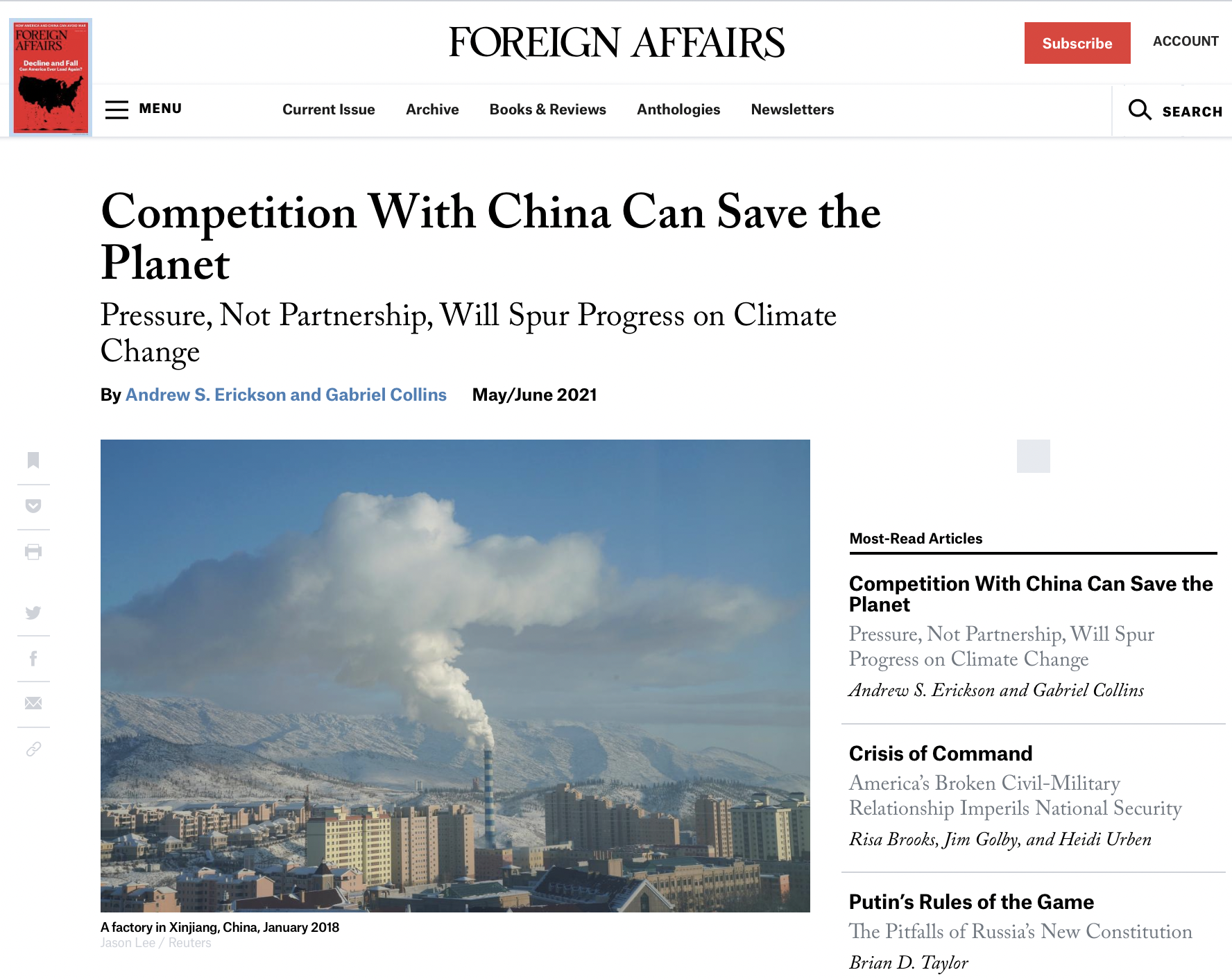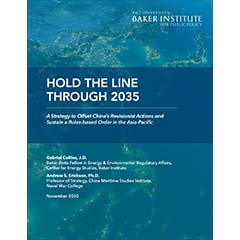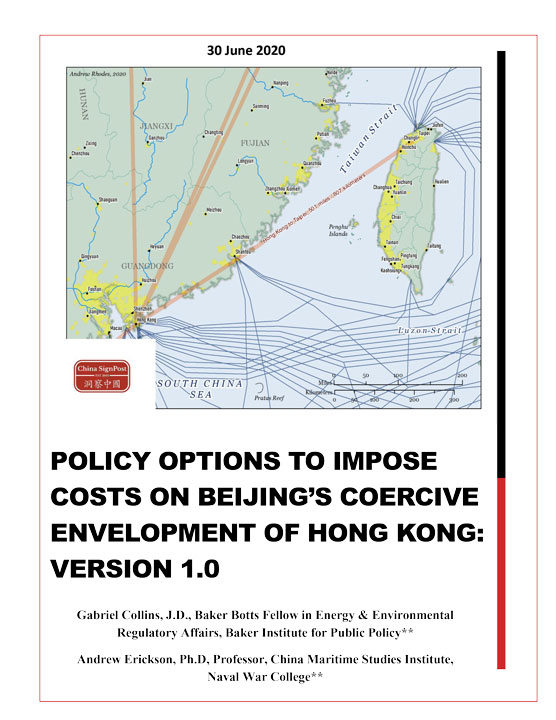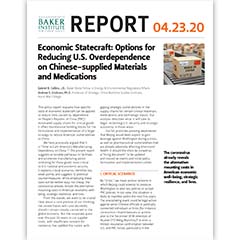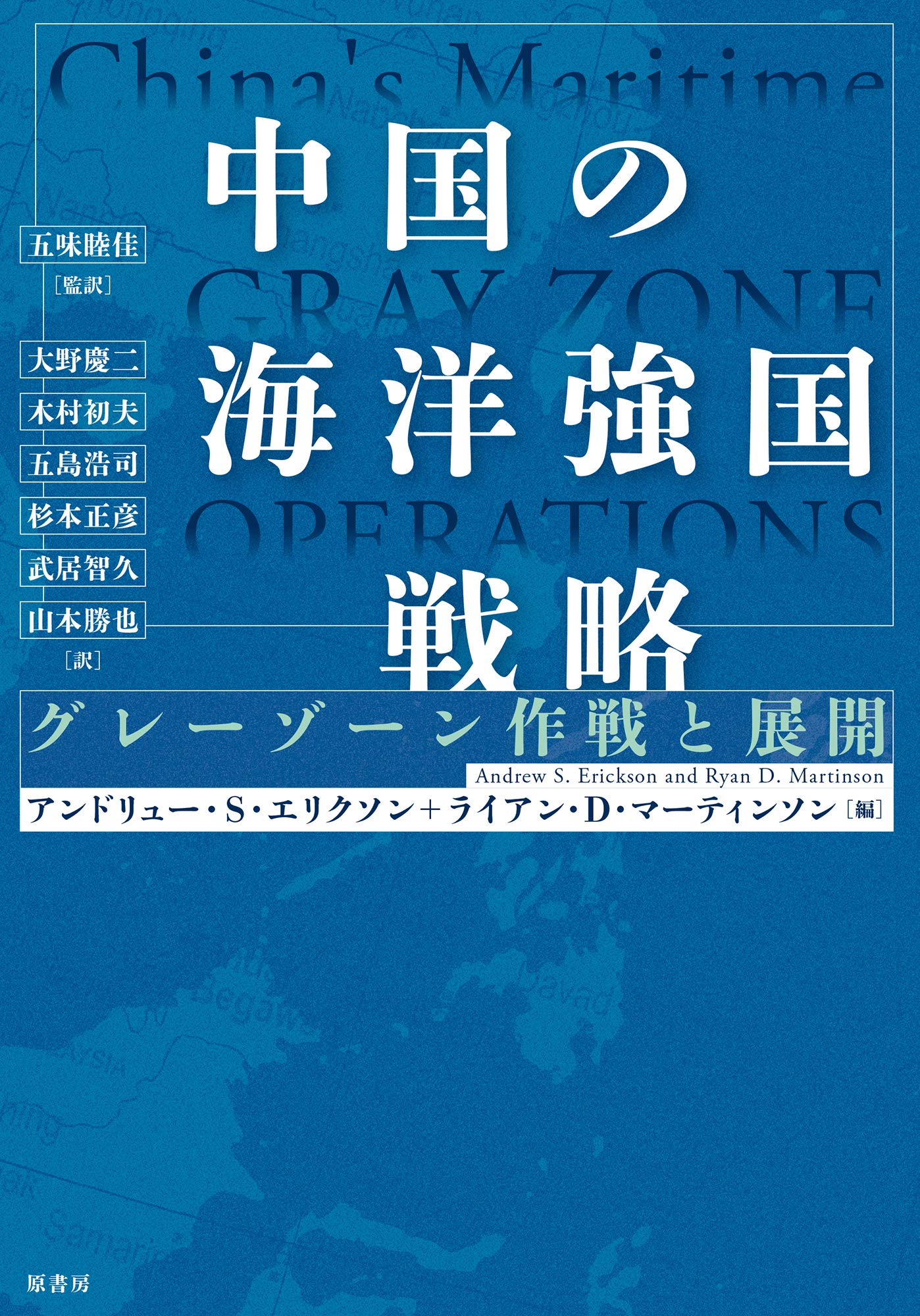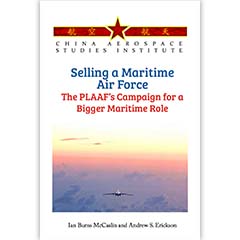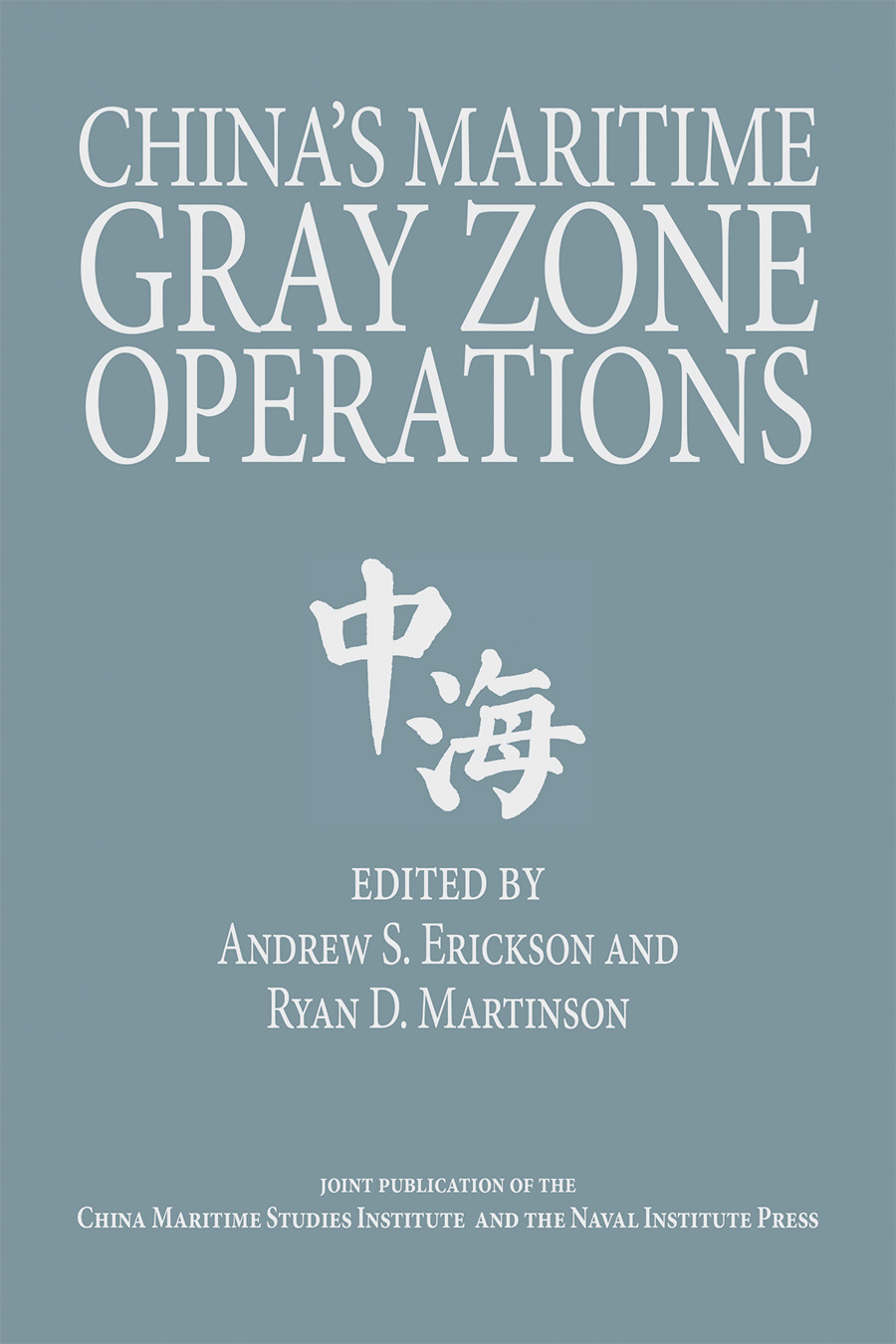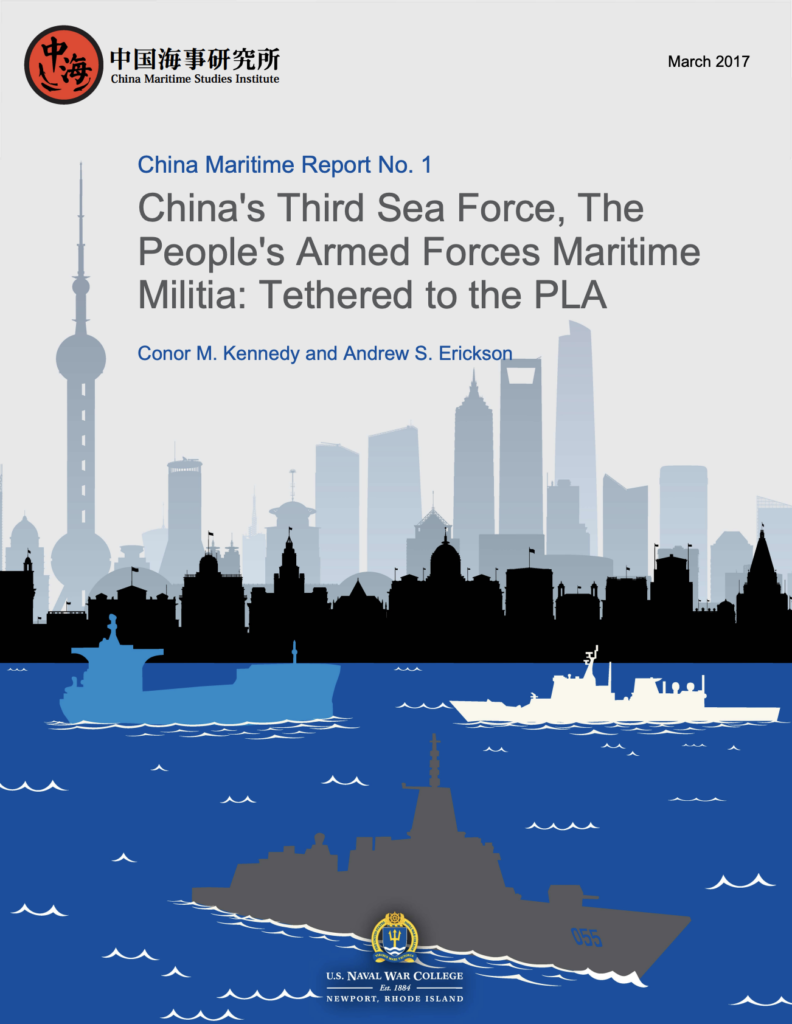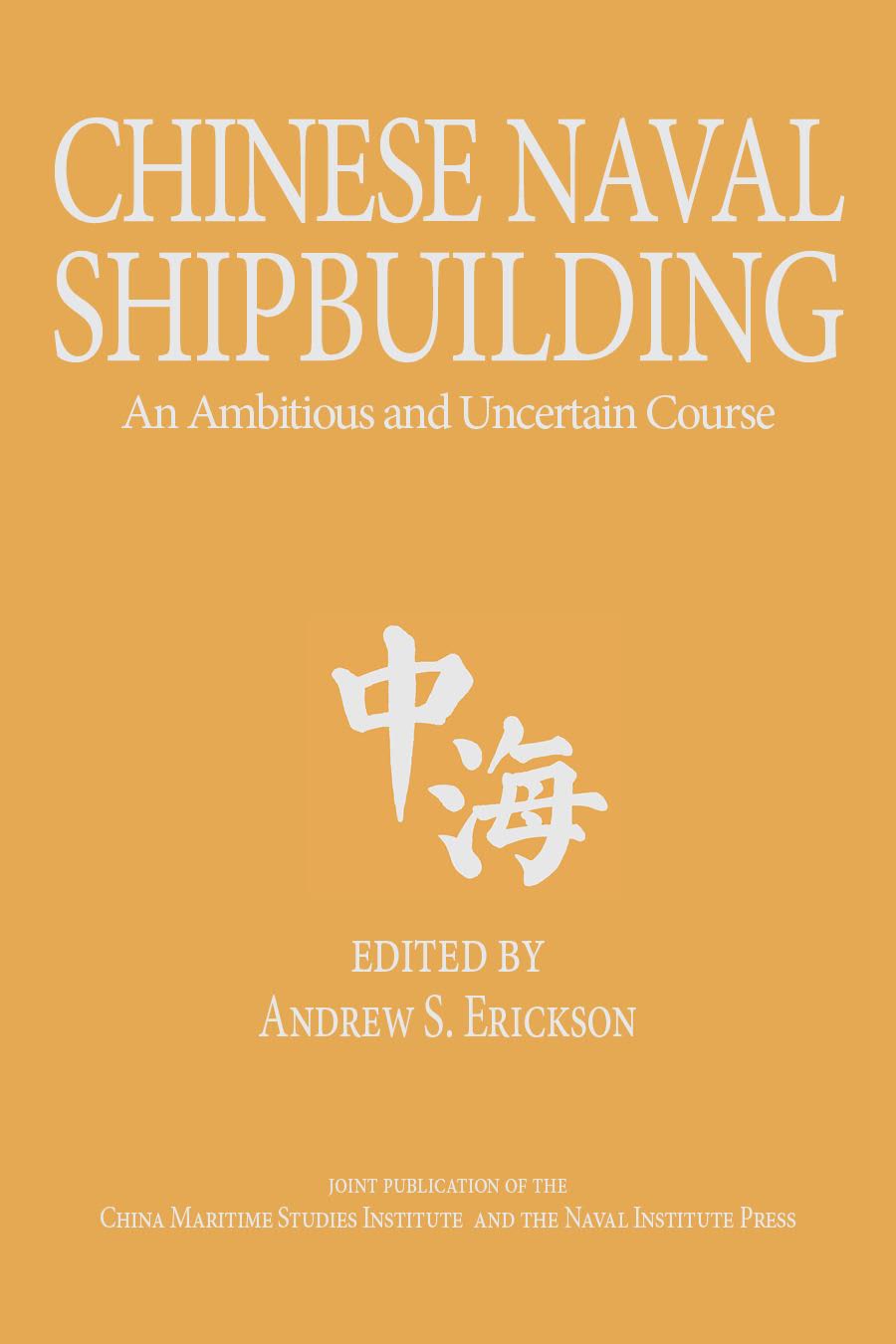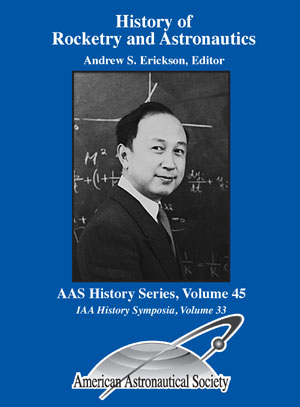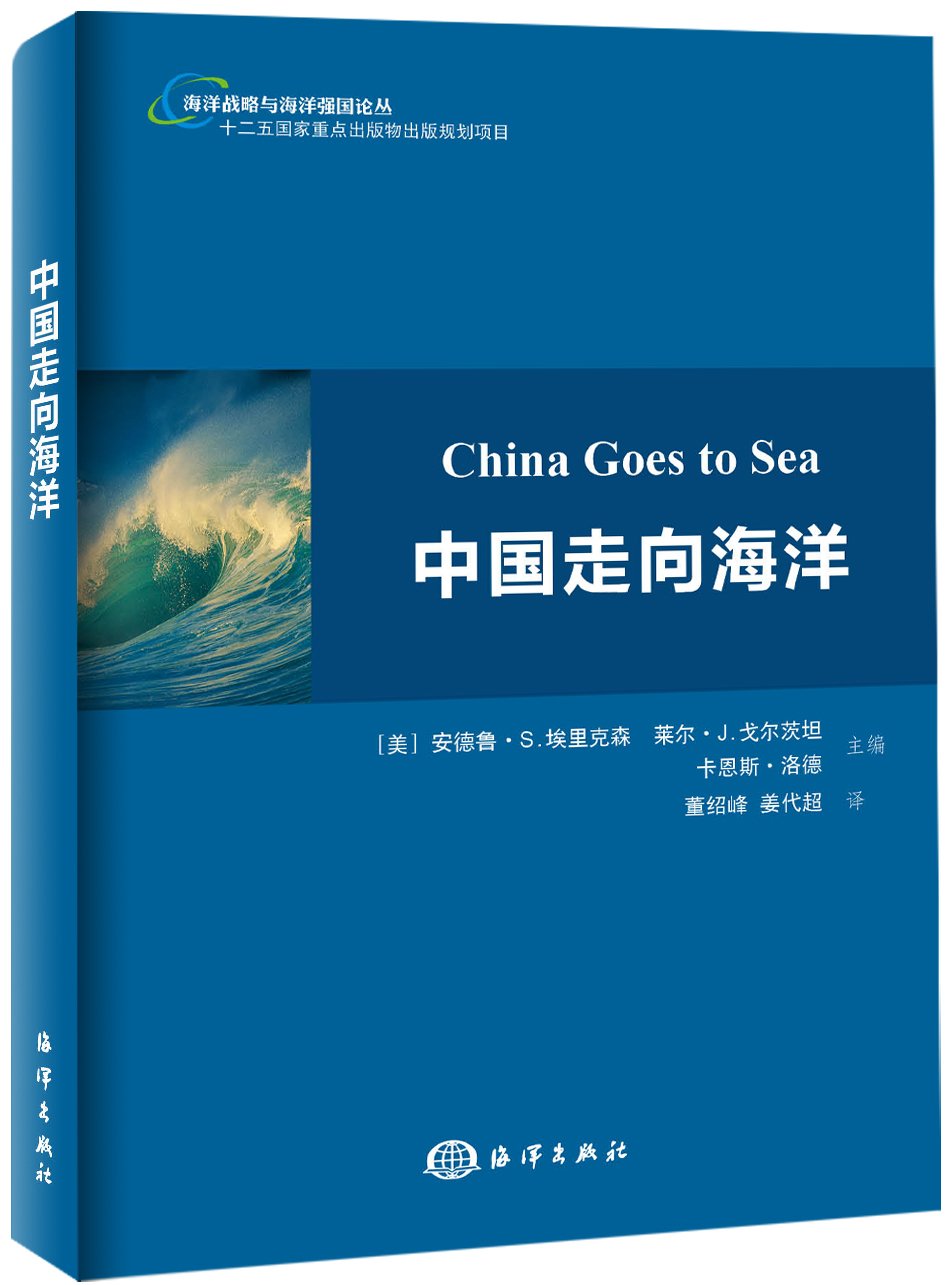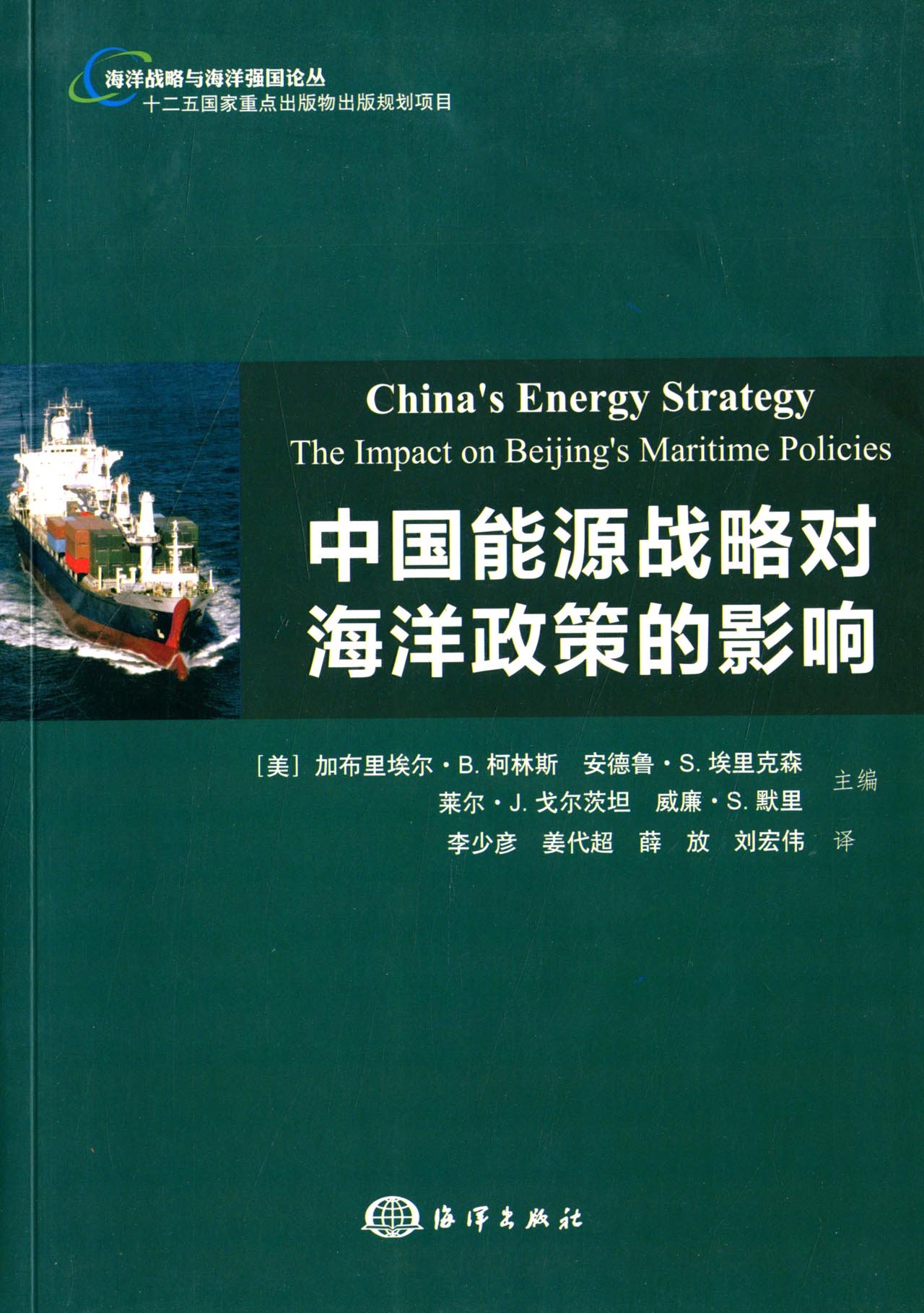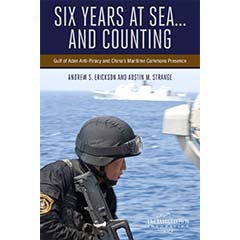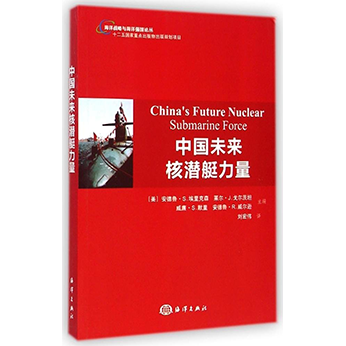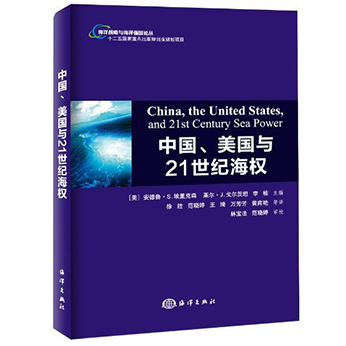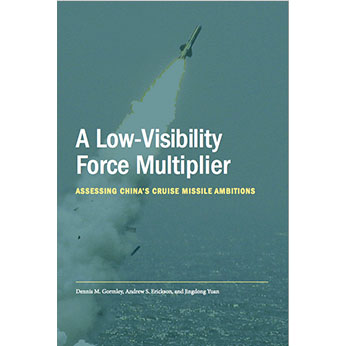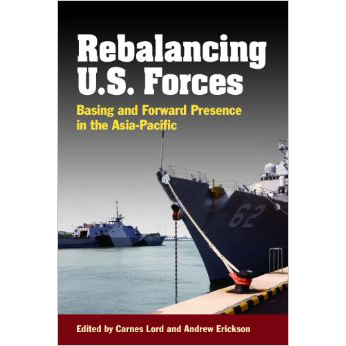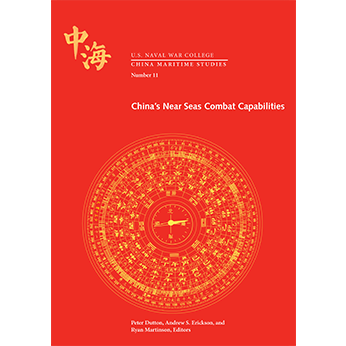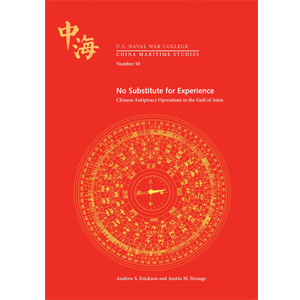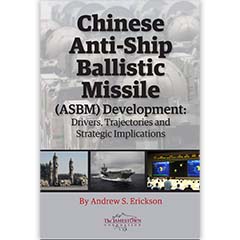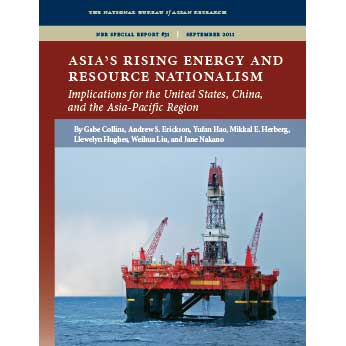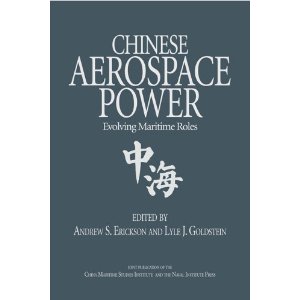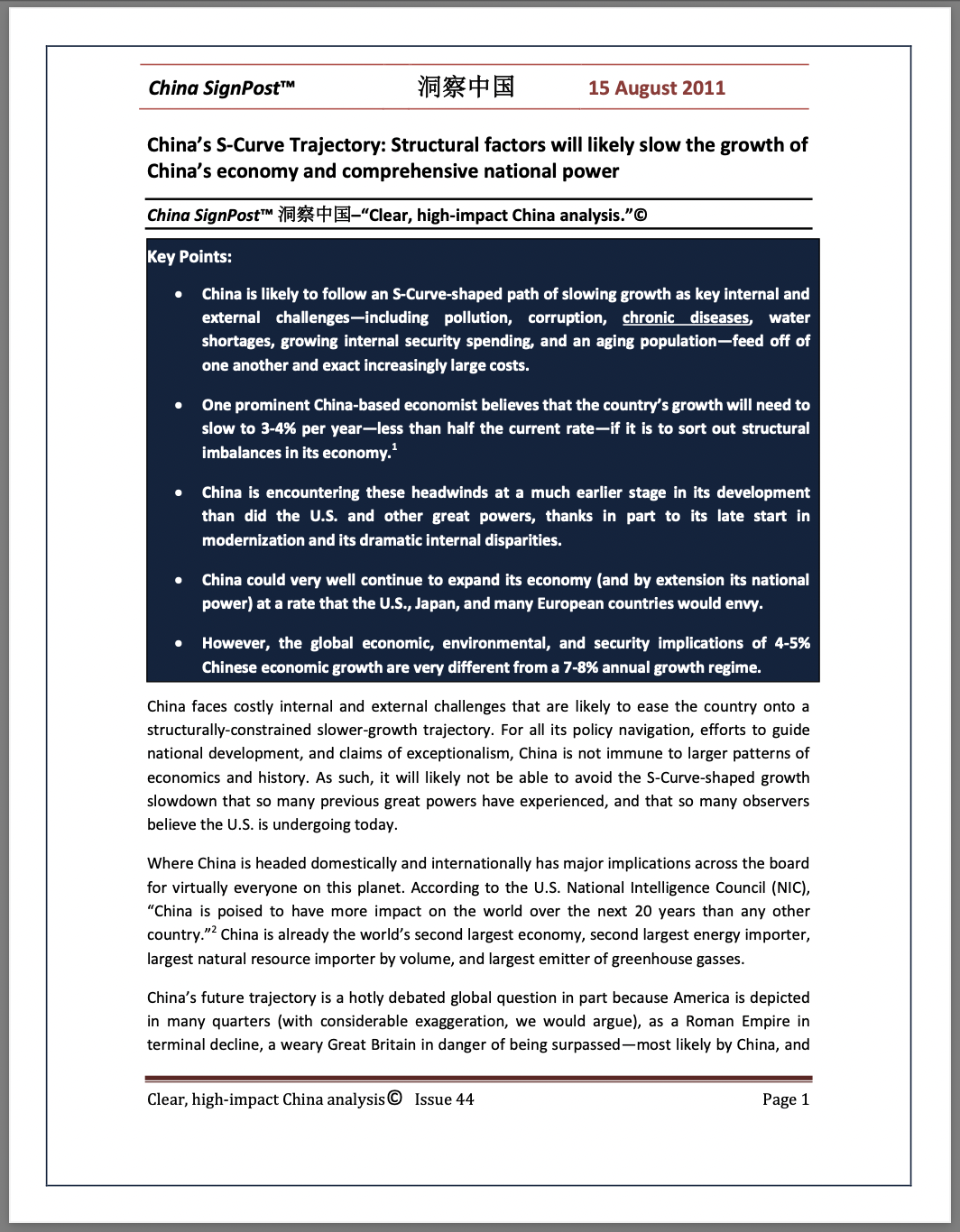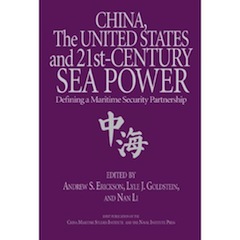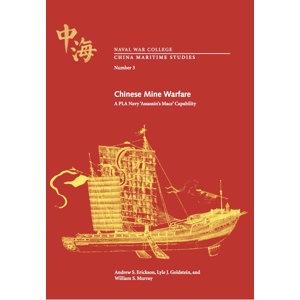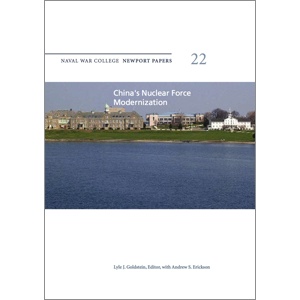Honored to Be Quoted in The Cipher Brief: “Beijing’s Rare Disclosure on DF-5B Missile Signals Shift in Nuclear Messaging”
Hollie McKay, “Beijing’s Rare Disclosure on DF-5B Missile Signals Shift in Nuclear Messaging,” The Cipher Brief, 30 June 2025.
“While the original DF-5 missile, developed during the Cold War, was outfitted with a single warhead, the DF-5B’s multi-warhead capacity—alongside its purported accuracy within 500 meters—represents a significant leap in China’s second-strike capability and nuclear survivability.”
“Andrew Erickson, a professor of strategy at the Naval War College and visiting China-focused scholar at Harvard University, believes that the renewed focus on this issue ‘is part of a comprehensive effort to attempt to coerce and intimidate its adversaries regarding the military scenarios about which Beijing prioritizes most.’”
“‘Beijing’s goal is to show that it can match or exceed its adversaries on each rung of the escalation ladder; and also has the capability to utilize rungs, or combination of rungs, that its adversaries either do not possess or are more hesitant to use,’ he explained.” …
“Erickson believes that China’s criticism of U.S. missile-defense efforts like the Golden Dome, ‘and collaboration with Moscow on hypocritical arms control grandstanding rings hollow when Beijing remains silent on, or tacitly condones, Russia’s development of dramatic space control measures,’ the most worrisome and threatening of which, is what would be the world’s first satellite-based nuclear weapon according to Erickson.” …
“‘Advanced nuclear weapons and delivery systems are the ultimate backstop supporting Beijing’s efforts to impose a Sisyphean sense of futility on its enemies while supporting the ultimate warfighting options should that preferred approach ultimately fail to deliver,’ Erickson said.” …
“Erickson contends that Beijing’s strategic ambiguity remains central to its doctrine: a tactic and a message.”
“‘China doesn’t want us to understand their deterrence strategy; that lack of clarity is baked into the ambiguity,’ he notes. ‘For twenty years of dialogue on these issues, the Chinese government and Chinese experts outside of government did not engage meaningfully. I don’t believe the PLA wants us to understand them.’” … … …
RELATED ANALYSIS:
My take on the Pentagon’s 2024 China Military Power Report!
I offer both TL;DR for the 182-page document and a hard-hitting conclusion.
- The bottom line: If Xi and the PLA were in the disarray some imagine, there’s no way China’s military could be developing, deploying, and exercising the way it clearly is.
- Instead, Beijing continues the most dramatic military buildup since World War II. That’s the overwhelming reality we—and Taiwan in particular—ignore at our peril.
- The proof is in the pudding, and the Pentagon just served up the biggest public dessert of the year.
Andrew S. Erickson, “What the Pentagon’s New Report on Chinese Military Power Reveals About Capabilities, Context, and Consequences,” War on the Rocks, 19 December 2024.
China’s military is both corrupt and increasingly capable. Yesterday, the Pentagon released its 24th China Military Power Report since Congress initiated its mandate in 2000, offering revelations unavailable elsewhere. The document reveals new details of the most dramatic military buildup since World War II, ongoing challenges that Chairman Xi Jinping and his party army are addressing with determination, and context to interpret what it all means. The bottom line: endemic corruption and lingering personnel and organizational weaknesses must be weighed against the Chinese Communist Party’s unrivaled ability to marshal resources and its ongoing production and deployment of advanced military systems on an unmatched industrial scale. Xi commands a system riven by brutal elite power struggles, but he is determined to pursue control over Taiwan with an increasingly potent toolkit. With deadly seriousness, he continues to advance sweeping organizational reforms to maximize relevant warfighting capabilities in fulfillment of his Centennial Military Building Goal of 2027, even at the cost of short-term churn and challenges.
Dramatic Developments: Nuclear Weapons, Manifold Missiles, Operational Options
Nothing looms larger than China’s determined advancements in nuclear weapons — arguably the ultimate military capability. By the report’s suspense date of “early 2024,” China already had more than 600 operational nuclear warheads, a surge from the more than 500 tabulated in last year’s edition. All of China’s roughly 400 intercontinental ballistic missiles can reach the continental United States.
China will likely have more than 1,000 operational warheads by 2030, most fielded on systems capable of ranging America’s homeland, many deployed at higher readiness. Stockpile growth will continue through 2035, which the Pentagon’s 2023 report projected “in line with previous estimates” and by which time the 2022 edition anticipated 1,500 warheads. Additional advanced nuclear delivery systems likely under development include strategic hypersonic glide vehicles and fractional orbital bombardment systems, the latter at least partially demonstrated in a 2021 test. These frontier efforts draw on potent dynamics, with the report judging that China “has the world’s leading hypersonic missile arsenal.”
Three new silo fields add 320 silos for solid-propellant intercontinental ballistic missiles. China is also more than doubling its DF-5 liquid-propellant intercontinental ballistic missile force to likely 50 silos. As part of an effort to upgrade older intercontinental ballistic missile families, including with multiple independently targetable reentry vehicles, at least 30 new silos will hold the DF-5C. The Pentagon also anticipates possible silo and rail deployment of DF-41 road-mobile intercontinental ballistic missiles, which have up to three warheads each.
Already, China’s rocket force keeps some nuclear forces on heightened alert. New silo-based intercontinental ballistic missiles, at least three early warning satellites, and Russian assistanceportend movement toward “early warning counterstrike” posture — what the United States terms “launch on warning.” In 2023, China test-launched two intercontinental ballistic missiles from training silos in western China. This suggests at least some new silo-based units will assume a launch on warning posture. … … …
***
Andrew S. Erickson, “Imposing the Fate of Sisyphus? The PLA as An Instrument of National Power and Force Preparation toward Taiwan,” in Benjamin Frohman and Jeremy Rausch, eds., The PLA in a Complex Security Environment: Preparing for High Winds and Choppy Waters (National Bureau of Asian Research, 15 May 2025), 149–74.
CLICK HERE TO DOWNLOAD A FULL-TEXT PDF OF MY CHAPTER.
This chapter examines the goals of the Chinese Communist Party (CCP) and People’s Republic of China (PRC) regarding Taiwan under Xi Jinping, how they are pursued through the development and use of the People’s Liberation Army (PLA) in extant and potential campaigns, and PRC perceptions of effectiveness and trends.
EXECUTIVE SUMMARY
MAIN ARGUMENT
Asserting control over Taiwan has been a CCP objective since 1943. The PLA’s posture and employment have strengthened, with capabilities increasing dramatically since the 1995–96 Taiwan Strait crisis. Through his “centennial military building goal” of 2027, Xi seeks a full range of options to coerce or conquer Taiwan. PLA forces, training, and operations are burgeoning accordingly. China currently pursues an all-domain pressure campaign and preparatory exercises, with some timed opportunistically to punish actions by Taiwan or its supporters. Future campaign scenarios include—individually and in combination—coercion or limited force, blockade, bombardment, or invasion. PRC perceptions regarding the effectiveness of Beijing’s actions and cross-strait trends vary but tend toward pessimism, thereby motivating potential use of force.
POLICY IMPLICATIONS
- Xi is rapidly prioritizing tremendous national resources in pursuit of military options regarding Taiwan that his predecessors lacked, with rapid and concerning results.
- New patterns of activity, including pressure operations and preparatory exercises, increasingly threaten, stress, and risk demoralizing Taiwan.
- Military-informed PRC sources insinuate that Washington’s and Taipei’s cross-strait policies and actions are trending in an unacceptable direction, reflecting a failure thus far by Beijing and the PLA to curb them completely; however, the PLA is on track to be able to offer the necessary deterrence or compellence, potentially through CCP authorization to take harsher, more coercive approaches and even credibly threaten war.
- Taiwan and the U.S. must urgently deploy asymmetric capabilities to deter PRC aggression.
Andrew S. Erickson is a Professor of Strategy in the China Maritime Studies Institute at the U.S. Naval War College.
The views expressed here are the author’s alone. He thanks Joshua Arostegui, Brian Davis, Ian Easton, Rob Englehardt, Julia Famularo, David Finkelstein, Conor Kennedy, Dan Kostecka, Ryan Martinson, James Mulvenon, William Murray, Adam Pace, Jeremy Rausch, and Christopher Sharman for their invaluable inputs.
CHAPTER SUMMARY FROM INTRODUCTION, pp. 9-10:
Is China Preparing for the Use of Force?
At the same time that its leaders express doubt over some aspects of the force’s ability to fight a large-scale modern conflict, the PLA is steadily increasing its presence and improving its readiness to carry out assigned missions around the PRC’s periphery and beyond. This volume’s final section explores the PLA’s changing force posture and capabilities around Taiwan, in Southeast Asia, and in the South Pacific and how Beijing is using the PLA as an instrument of power to deter challenges to its interests and seize opportunities in pursuit of its goals.
In the section’s opening chapter, Andrew Erickson examines the PLA’s posture toward Taiwan and the force’s growing capabilities and options for conducting a cross-strait offensive campaign. Erickson argues that Xi Jinping is devoting tremendous national resources to improve the PLA’s options for an offensive operation against Taiwan and that his “centennial military building goal” of 2027 represents a major milestone for developing a full range of options to coerce or conquer the island. At the same time, Erickson finds that many Chinese writings suggest that Beijing does not yet believe the time is ripe to initiate a military conflict against Taiwan and that “peaceful reunification” remains the least costly way for resolving cross-strait political differences. Others, however, express greater willingness to use military coercion and even force to bring Taiwan under Beijing’s control. Erickson suggests that this view may be manifested in the PLA’s increasing use of military exercises and other pressure tactics to demoralize Taiwan’s leaders and population and instill a sense of futility in resisting the PRC’s growing national power.
SAMPLE TEXT
This chapter examines Xi Jinping’s strategic objectives vis-à-vis Taiwan and the pursuit of those objectives through the People’s Liberation Army (PLA), assesses key trends, and considers whether the People’s Republic of China (PRC) perceives these efforts as effective. Its main argument is that Xi’s policies have increased military funding and capabilities, aiming to impose a Sisyphean sense of futility on Taiwan to compel unification without direct conflict. The ambition of the Chinese Communist Party (CCP) to control Taiwan has been steadfast for decades, significantly bolstered by enhanced PLA capabilities following the 1995–96 Taiwan Strait crisis. Xi’s 2027 “centennial military building goal” calls for comprehensive options to coerce or conquer Taiwan. China’s military has achieved substantial growth in forces and training, aligning with Beijing’s all-domain pressure campaign and strategic exercises aimed at preparing for scenarios including coercion, blockade, bombardment, and invasion. Policy implications are profound: Xi is directing tremendous resources toward military options regarding Taiwan, gravely threatening Taiwan’s security and morale. CCP leaders perceive current Taiwanese and U.S. policies as adverse, necessitating harsher measures and potentially credible threats of war. To counter PRC aggression, Taiwan and the United States must urgently deploy asymmetric capabilities.
This chapter first surveys the historical context and PLA development. Following the PRC’s establishment in 1949, Mao Zedong intended to invade Taiwan to conclude the Chinese Civil War on Beijing’s terms. However, plans were canceled due to intelligence failures and the Korean War. Over subsequent decades, the PLA’s capabilities were insufficient to challenge the U.S.-patrolled Taiwan Strait. This changed after the Cold War, with missile strikes becoming a feasible cross-strait option. Under Xi, Taiwan faces increasing danger. China’s military focus has been on achieving jointness and technological sophistication to prevail in potential U.S. intervention contingencies. Xi’s 2027 military goal emphasizes a toolbox of capabilities to coerce or conquer Taiwan, driven by perceived time constraints and a closing window of opportunity. Second, the chapter reviews operational posture and training. China’s military posture toward Taiwan has evolved significantly, marked by the most extensive buildup since World War II, largely focused on Taiwan. Xi’s military reforms from 2015 to 2016, including the strengthening of existing forces and creation of new ones, have enhanced the PLA’s readiness for high-end Taiwan contingencies. Third, the chapter weighs Xi’s peacetime and wartime options. Beijing employs a multifaceted strategy, leveraging military, diplomatic, informational, and economic pressure. China’s military engages in frequent exercises to prepare while stressing Taiwan’s defenses. Beijing’s approach includes coercive activities short of full-scale war, ranging from political and disinformation operations to limited (para)military use. These efforts aim to compel Taiwan to capitulate without major combat, but more aggressive measures (e.g., blockade or bombardment) are increasingly robust options. An outright amphibious invasion, the most complex and risky, would likely be a last resort. Fourth, the chapter assesses trends of increasingly pessimistic PRC perceptions. It concludes that Xi’s rapid military buildup, emphasizing coercion and potential force, increases the risk of conflict with Taiwan, the United States, and allies and makes deterrence of utmost urgency. … … …
VOLUME INFORMATION
Book from the People’s Liberation Army Conference
The PLA in a Complex Security Environment:
Preparing for High Winds and Choppy Waters
The PLA in a Complex Security Environment: Preparing for High Winds and Choppy Watersfeatures papers from the 2023 People’s Liberation Army Conference convened by the National Bureau of Asian Research, U.S. Indo-Pacific Command’s China Strategic Focus Group, and the Miller Center of Public Affairs at the University of Virginia. The volume examines how Chinese leaders assess China’s external security environment, including both the opportunities and threats presented; how this assessment is driving changes to the PLA’s strategy, planning, and modernization efforts; and how the PLA’s posture and capabilities are evolving in key theaters of interest to the United States, including the Taiwan Strait, Southeast Asia, and the South Pacific.
CONTENTS
Foreword to The PLA in a Complex Security Environment: Preparing for High Winds and Choppy Waters
Introduction: China’s Military Strategy and Posture in an Increasingly Complex Security Environment
“Profound Changes Unseen in a Century”: China Assesses Its Security Environment
Stabilizing the Boat: Revisiting Party-Army Relations under Xi Jinping
China’s Transition to a War-Oriented National Defense Mobilization System
Lumbering toward the China Dream: The PLA’s Strategic Mission Through 2049 and Beyond
PRC Lessons Learned from Russia’s Invasion of Ukraine: Implications for a Taiwan Conflict
Assessing the PLA’s Strengths and Weaknesses for Achieving the PRC’s Goals
The PLA as a Part of China’s Strategy in Southeast Asia
Competing for Access: China’s Growing Security Interest in the Pacific Islands
Foreword to The PLA in a Complex Security Environment: Preparing for High Winds and Choppy Waters
I am honored to present The PLA in a Complex Security Environment: Preparing for High Winds and Choppy Waters, the latest volume from an essential conference series on the Chinese People’s Liberation Army (PLA) convened by the National Bureau of Asian Research (NBR), the China Strategic Focus Group at United States Indo-Pacific Command, and the University of Virginia’s Miller Center of Public Affairs. This volume explores how the Chinese Communist Party (CCP) is thinking about the use of force in an increasingly complex security environment and assesses the CCP’s capability to employ the PLA to achieve its strategic objectives. The superb work of the authors provides a rigorous and insightful assessment of how CCP threat assessments are driving the PLA’s modernization efforts, strategy, and operational posture.
China continues its aggressive military buildup through a rising defense budget, a rapidly modernizing conventional force, an exponential increase in space-based capabilities, and an alarming nuclear weapons expansion. Beijing also continues to wage increasingly aggressive gray-zone operations against U.S. allies and partners in the Indo-Pacific region, significantly raising the risk of an incident or miscalculation that could lead to loss of life or spark a wider conflict. In the Taiwan Strait, Beijing is employing all elements of comprehensive national power to coerce Taiwan and the international community to accept that unification is, in fact, inevitable. Although China claims it prefers to achieve unification through peaceful means, Xi Jinping will not renounce the use of force. These actions pose an important question for the U.S. Department of Defense, interagency, and broader China-watching community: to what extent is Xi preparing China for war?
This PLA Conference volume contributes to the expanding global conversation on China strategic intentions by examining the CCP’s perceptions of China’s external security environment and tracing how these judgments direct whole-of-society preparations for intensifying strategic competition with the United States. It offers unique insights into the primary ideological lens through which Beijing assesses its security environment, as well as the impacts these assessments have on party-army relations. The volume then leverages this context to explore how the PLA’s missions, strategy, and operational posture are evolving along with whole-of-society efforts to compete with the West. It also examines the lessons the PLA may be drawing from Russia’s invasion of Ukraine, including how the PLA may be applying these lessons to its assessments of its own strengths and weaknesses. Finally, the volume assesses three operational theaters—Taiwan, Southeast Asia, and Oceania—and the future role of the PLA in achieving its objectives in each.
This work offers insights for understanding China’s strategic approach to military modernization for potential unification by force that planners, policymakers, and warfighters can leverage toward designing effective and achievable objectives. I am proud to sponsor this conference, and I commend the organizers and participants who contributed their collective discernment to make this volume possible.
Admiral Samuel J. Paparo is Commander of the United States Indo-Pacific Command.
***
Andrew S. Erickson, “China’s Approach to Conventional Deterrence,” Chapter 1 in Roy D. Kamphausen, ed., Modernizing Deterrence: How China Coerces, Compels, and Deters(Seattle, WA: National Bureau of Asian Research, 2023), 12–27.
pp. 3–4
Andrew Erickson of the U.S. Naval War College and Nicola Leveringhaus of King’s College London begin the volume with chapters surveying how the PRC has traditionally considered and employed deterrence in the conventional and strategic domains.
In the first chapter, Erickson explores how Beijing poses unique conventional deterrence challenges through its advanced missile systems, opaque decision-making and signaling, and disregard for confidence building. Erickson argues that under Xi Jinping, the PRC is achieving increasingly potent tailored conventional capabilities that could be employed at virtually every rung of the escalation ladder, thereby offering leaders more options and leverage against potential adversaries. While China’s approach to “integrated strategic deterrence” historically has encompassed both nuclear and conventional deterrence, the conventional component is in some ways the more important, if not fully understood by Western observers. China’s rapid pursuit of a range of state-of-the-art systems is making its long-risky calculus concerning conventional deterrence still more destabilizing and dangerous in practice. For instance, Erickson notes that PRC researchers view ballistic missiles outfitted with hypersonic glide vehicles as a transformative technology that China must emphasize in response to similar U.S. (and Russian) developments. In view of Beijing’s increasing risk tolerance and assertiveness, coupled with the rapid development of the PLA’s capabilities to support such a posture, Erickson emphasizes that a comprehensive re-evaluation of PRC strategic thinking regarding conventional deterrence is required.
Chapter 1
China’s Approach to Conventional Deterrence
Andrew S. Erickson
This chapter argues that the People’s Republic of China (PRC) poses unique conventional deterrence challenges through its unparalleled buildout of cutting-edge missiles combined with its opacity and dismissal of restraints.
MAIN ARGUMENT
Under Xi Jinping, the PRC is increasingly achieving potent, tailored conventional capabilities that could be employed at every level of the escalation ladder. Beijing’s increasing risk tolerance and assertiveness, particularly vis-à-vis disputed sovereignty claims such as Taiwan—together with its meteoric development of military capabilities to support such a posture—require a comprehensive re-evaluation of deterrence in PRC strategic thinking. China’s approach to “integrated strategic deterrence” historically has been broad, encompassing both nuclear and conventional deterrence across competition, crisis, and conflict. The conventional component is in some ways the most important, yet the least studied by Western observers. A panoply of elements, systems, capabilities, and missions are intertwined with Chinese approaches to conventional deterrence. Likewise, since their formal elevation in strategic importance in the early 1990s, conventional missiles have had a leading position in the modernization of the People’s Liberation Army (PLA). China’s rapid military buildup, centered on conventional missile systems, gives achieving an updated understanding of Beijing’s conventional deterrence calculus unprecedented importance. Such understanding is complicated by China’s deliberate opacity and unwillingness to be forthcoming or embrace meaningful guardrails in either public announcements or private engagement.
POLICY IMPLICATIONS
- PLA source suggestions of China possessing conventional intercontinental ballistic missiles in the future, including those outfitted with hypersonic glide vehicles, raise the possibility of serious, unintended escalation.
- Long-held overconfidence in “calibrated deterrence”—and the signaling that it implies—is the most dangerous element of Chinese thinking with regard to deterrence and warfighting.
- U.S. decision-makers must unambiguously uphold the credibility of U.S. conventional and nuclear deterrence, including extended deterrence to protect allies from PRC nuclear and conventional threats.
CHAPTER TEXT
Under Xi Jinping, the People’s Republic of China (PRC) is increasingly achieving powerful bespoke conventional capabilities that could be employed at virtually every level of the escalation ladder, thereby offering PRC leaders more rungs, options, and leverage in the international arena. Beijing’s increasing risk tolerance and assertiveness, particularly vis-à-vis disputed sovereignty claims (e.g., Taiwan)—together with its meteoric development of military capabilities to support such a posture—require a comprehensive re-evaluation of deterrence in PRC strategic thinking. China’s approach to “integrated strategic deterrence” historically has been extremely broad, encompassing both nuclear and conventional deterrence across competition, crisis, and conflict.1 Amid current PRC views on deterrence, the conventional component is in some ways the most important, yet the least studied by Western observers. A panoply of elements, systems, capabilities, and missions—regarding cyber and space in particular, as well as aviation, information, and disinformation—are used in Chinese approaches to conventional deterrence. Likewise, since their formal elevation in strategic importance in the early 1990s, conventional missiles have had a leading position in the modernization of the People’s Liberation Army (PLA).
This chapter focuses on the PLA’s conventional missile and strike capabilities—including hypersonic glide vehicles (HGVs) now under development2—and specifically forces and weapons systems within the PLA Rocket Force.3 The elevation of the force to a full service on December 31, 2015, reflects its strategic importance. To elucidate approaches to conventional deterrence in PLA strategy, the chapter assesses PRC views on conventional deterrence definitions, concepts, and doctrine; surveys PLA conventional missile organization and force structure; considers potential scenarios; and offers corresponding conclusions and policy recommendations. The chapter also documents changing doctrinal, organizational, force modernization, training, and other elements of the PLA’s conventional deterrence. … … …
DISCLAIMER & ACKNOWLEDGMENTS
The views expressed in this chapter are those of the author alone. He thanks Cristina Garafola, Alastair Iain Johnston, the National Bureau of Asian Research, and anonymous conference participants and reviewers for invaluable comments.
FOOTNOTES
1 Michael S. Chase, “PLA Rocket Force: Executors of China’s Nuclear Strategy and Policy,” in China’s Evolving Military Strategy, ed. Joe McReynolds (Washington, D.C.: Jamestown Foundation, 2016), 141–72; and Michael S. Chase and Arthur Chan, China’s Evolving Approach to “Integrated Strategic Deterrence” (Santa Monica: RAND Corporation, 2016).
2 All ballistic missiles are hypersonic (faster than Mach 5) at some point in their flight. Germany’s V-2, deployed in September 1944, was hypersonic during its boost phase. Intercontinental ballistic missiles, first deployed by the United States in 1959, are high hypersonic (Mach 25) throughout their entire flight. Subsequent decades have witnessed the emergence of hypersonic missile systems that can maneuver instead of following a fixed parabolic trajectory, including anti-ship ballistic missiles (ASBMs), HGVs, and air-breathing supersonic combustion ramjets (scramjets). The United States investigated maneuvering re-entry vehicles in the late 1970s, and the Soviet Union investigated HGVs in the mid-1980s; both failed. In 1981 the United States fielded the Pershing II medium-range ballistic missile (MRBM), whose terminal braking maneuver has been widely attributed to China’s DF-21D and DF-26B ASBMs. In April 2010 the United States successfully tested the first HGV, the Falcon HTV-2. The restarted Russian HGV research and development effort (Project 4202, which would become the Avangard) appears to have taken a little longer. What is “new” is the recent fielding of mature, hypersonic missiles with maneuvering payloads by U.S. adversaries. Russia has developed the Avangard HGV and has fielded, or will soon field, the scramjet-powered 3M22 Zircon hypersonic cruise missile. China has fielded the aforementioned DF-21D and DF-26B ASBMs, as well as the DF-17 (likely with the DF-ZF HGV). All of these systems use speed and maneuverability to greatly complicate the defender’s problem. Maneuvering potentially enables approaching from unexpected angles to strike a moving target on land or sea. Nonparabolic trajectory allows approaching at lower altitude. Trade-offs include slowing significantly (typically below Mach 10) to mitigate the ionized plasma field that inhibits active radar sensors typically employed to seek targets.
3 While the PLA Rocket Force remains the mainstay for conventional deterrence missions regarding long-range strikes, there are increasingly roles and missions to which the PLA Air Force, Navy, and even Ground Force contribute. The PLA Air Force has fielded roughly 100 modernized H-6 bombers in recent years, many of which are capable of carrying six CJ-20 land attack cruise missiles (LACMs) and can reach Guam. Additionally, the H-6N bomber is fielding a nuclear-capable air-launched ballistic missile (ALBM), the CH-AS-X-13, and China is also working on the H-20 low-observable strategic bomber with assessed nuclear and conventional roles. PLA Navy surface vessels are fielding anti-ship cruise missiles (ASCMs) ranging from 250 kilometers to over 500 kilometers. Larger combatants will obtain ASBMs, and some ships will get LACMs, too. PLA Navy submarines may field long-range LACMs as well. PLA Navy Aviation has a relatively long-range ASCM role with the supersonic YJ-12 (up to around 250 kilometers). Even in the PLA Ground Force, long-range artillery ranges several hundred kilometers.
… … …
INFORMATION ON EDITED VOLUME
Modernizing Deterrence: How China Coerces, Compels, and Deters features papers from the 2021 People’s Liberation Army Conference convened by NBR and U.S. Indo-Pacific Command’s China Strategic Focus Group. Leading experts explore how the PLA’s modernizing capabilities and evolving doctrine suggest that a fundamental shift in China’s approach to deterrence may be underway. Taken together, the nine chapters collected in this volume reveal broad changes to China’s deterrence strategy across conventional, strategic, asymmetric, and emerging domains and consider how Chinese strategists and planners assess the PLA’s ability to navigate conflict scenarios when deterrence fails.












